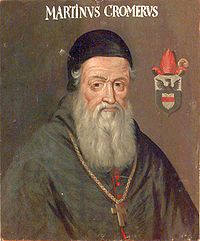- Marcin Kromer
-
Marcin Kromer or Martin Cromer (German: Martin Cromer, 1512 in Biecz – 23 March 1589 in Lidzbark Warmiński) was Prince-Bishop of Warmia (Ermland), a cartographer, diplomat and historian in Poland and later in the Polish-Lithuanian Commonwealth. He was personal secretary to two Kings of Poland, Sigismund I the Old and Sigismund II Augustus.
Contents
Life
Kromer was born in 1512 into a prominent ethnic Forest German burgher family in Biecz, in Lesser Poland. He completed his basic education in a local church-run school. In 1528 he transferred to Kraków, where in 1530 he graduated as a bachelor at the Cracow Academy. In 1533–37 he worked at the Royal Chancellery in Kraków. Thereafter he went to Italy, where he studied law for two years. Returning to Poland in 1540, he became secretary to Archbishop Peter Gamrat. As the latter's personal advisor, he was also his envoy and representative to Rome, where he spent two years until 1544. He then became a canon in Kraków.
In 1545, upon the death of his mentor, Kromer accepted the latter's post as personal secretary to Poland's King Sigismund I the Old. He was also an associate of Samuel Maciejowski, who later became Chancellor of the Crown. A specialist on Royal Prussia and Warmia, in 1551 Kromer became head of the Warmian canonry. However, his church career did not proceed as planned, since he was seen as one of the best Polish diplomats of the age and was frequently required by the court to leave his post to serve as envoy on various diplomatic missions. In 1552, for his services to the King, he was ennobled and granted a coat of arms.
From 1558 to 1564 Kromer served as Polish envoy to Emperor Ferdinand I, who in recognition of Kromer's services added his own family coat-of-arms to Kromer's. The latter's tasks included advocacy of King Sigismund's claims to the inheritance of the late Queen-Consort Bona Sforza, which was also claimed by the King of Spain, who, however, based his claims on a forged testament.
In 1564 Kromer was recalled to Poland, where he was promoted within the church hierarchy and took the post of coadjutor (de facto bishop) of the Bishopric of Warmia, to succeed on the demise of Prince-Bishop Stanislaus Hosius. After nine years at that post, Kromer was officially promoted to Prince-Bishop. He spent the rest of his days in Warmia, keeping diaries and writing several books on the history of Poland. He died on 23 March 1589 in Heilsberg (Lidzbark Warmiński).
In his works, Kromer advocated the reform of Poland's scientific and cultural life. One of his notable demands was providing the Cracow Academy with new privileges to restore its position as one of the renowned universities in Central Europe. He also promoted the active defence of the Roman Catholic Church against the growing Reformation.
Martin Kromer and Stanislaus Hosius (Stanisław Hozjusz) were the two bishops most instrumental in causing Royal Prussia's diocese of Warmia to return to or remain Catholic during a time of major conversions to Protestantism, especially in the neighboring Duchy of Prussia which almost surrounded the Prince-Bishopric of Warmia, and had converted to Lutheranism as the first state to do so.
Kromer and Hosius left many German-language records of their speeches and sermons in their episcopacies in Ermland (Warmia).
Works
Marcin Kromer published His works in Latin and Polish language.[1]
In Latin
- Musicae elementa, Kraków, 1532,survived only one fragment: De plana musica liber prior.
- Martini Cromeri Sermo de tvenda dignitate sacerdotii, Petricoviae in Synodo habitus, Kraków, 1542,
- Martini Cromeri De origine et rebvs gestis Polonorvm libri XXX. Adiecta est in fine, eiusdem autoris funebris Oratio Sigismvndi regis uitam compendiose complexa, 1555,
- Martini Cromeri Varmiensis Episcopi Polonia: siue de origine et rebus gestis Polonorum libri XXX [1] of 1555 (About origins and history of Poles in thirty books) in Latin, (Polish translation O sprawach, dziejach i wszystkich innych potocznościach koronnych polskich published in Cologne 1589,
- Polonia sive de situ, populis, moribus, magistratibus et Republica regni Polonici libri duo published in Cologne in 1577 (Poland, about location, culture and offices) in Latin, (Polish translation Polska, czyli o położeniu, obyczajach, urzędach Rzeczypospolitej Królestwa Polskiego in 1853)
- Catecheses sive Institvtiones dvodecim de septem Sacramentis & sacrificio Missae & de funeribus exequiis : ad vtilitatem parochorum & aliorum Sacerdotum, in Polonicam Germanicamq[ue] linguam conversae Kraków, 1570,
- Oratio Martini Cromeri in fvnere optimi & maximi principis, Sigismundi, eius nominis primi Polonorum, Litvanorum, Russorum, Prussorum, & Masouiorum Regis, etc., Kraków, 1548,
In Polish
- Rozmowa dworzanina z mnichem, Czego sye krzesciyánski człowyek dźyerżeć ma : mnichá z dworzáninem rozmowa wtora of 1551-1554 (in Polish: "Discourse between a courtier and a monk")
- Historyja prawdziwa o przygodzie żałosnej książęcia finlandzkiego Jana i królewny polskiej Katarzyny from 1570, (in Polish: "true history of sad adventure of Finnish prince John and Polish princess Catherine"), a prose telling of love between John III of Sweden and Catherine Jagellonica, parents to Sigismund III Vasa[2]
Bibliography
- F. Hipler, Die deutschen Predigten und Katechesen der ermländischen Bischöfe Hosius und Cromer, Cologne, 1885
See also
References
- ^ Zdzisław Libera,Jadwiga Pietrusiewiczowa,Jadwiga Rytel. Od średniowiecza do oświecenia. t. I, 1989. s. 76.
- ^ Marcin Kromer - Historyja prawdziwa o przygodzie żałosnej książęcia finlandzkiego Jana i królewny polskiej Katarzyny, oprac. Janusz Małłek, wyd. Pojezierze - Olsztyn 1983,ISBN 83-7002-118-2
External links
Catholic Church titles Regnal titles Preceded by
Stanislaus HosiusPrince-Bishop of Warmia (Ermland)
1579–1589Succeeded by
Andrew BáthoryCategories:- 1512 births
- 1589 deaths
- 16th-century Roman Catholic bishops
- Bishops of Warmia
- Prince-Bishops
- Polish nobility
- Polish historians
- Diplomats of the Polish–Lithuanian Commonwealth
- Alumni of Jagiellonian University
- Polish music theorists
- Ecclesiastical senators of the Polish–Lithuanian Commonwealth
- Polish Princes of the Holy Roman Empire
Wikimedia Foundation. 2010.


